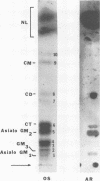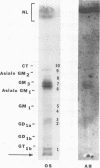Abstract
By use of a thin-layer chromatogram (TLC) overlay procedure, 35S-labeled acanthamoebae were shown to bind to seven glycolipids of rabbit corneal epithelium. Corneal epithelial cells were grown in culture and were subjected to Folch extraction to isolate a chloroform-rich lower phase containing neutral glycosphingolipids (NGSL) and an aqueous upper phase containing gangliosides, i.e., sialic acid-containing glycolipids. Thin-layer chromatography of the upper phase revealed the presence of 10 ganglioside components. Acanthamoebae were shown to bind to four of these components, referred to as 2, 3, 6, and 7. On TLC plates, ganglioside components 2 and 3 migrated slightly ahead of the glycolipid standard GD1a, component 7 comigrated with standard GM3, and component 6 migrated a little more slowly than GM3. Likewise, of the 10 NGSL known to be present in the lower phase, acanthamoebae bound to components 1, 5, and 6. NGSL components 1, 5, and 6 migrated on TLC plates with relative mobilities similar to those of standards asialo GM1, asialo GM2, and ceramidetrihexoside, respectively. We propose that one or more of the Acanthamoeba-reactive glycolipids of corneal epithelium identified in this study may play a role in the pathogenesis of Acanthamoeba keratitis by mediating the adherence of the parasites to the cornea.
Full text
PDF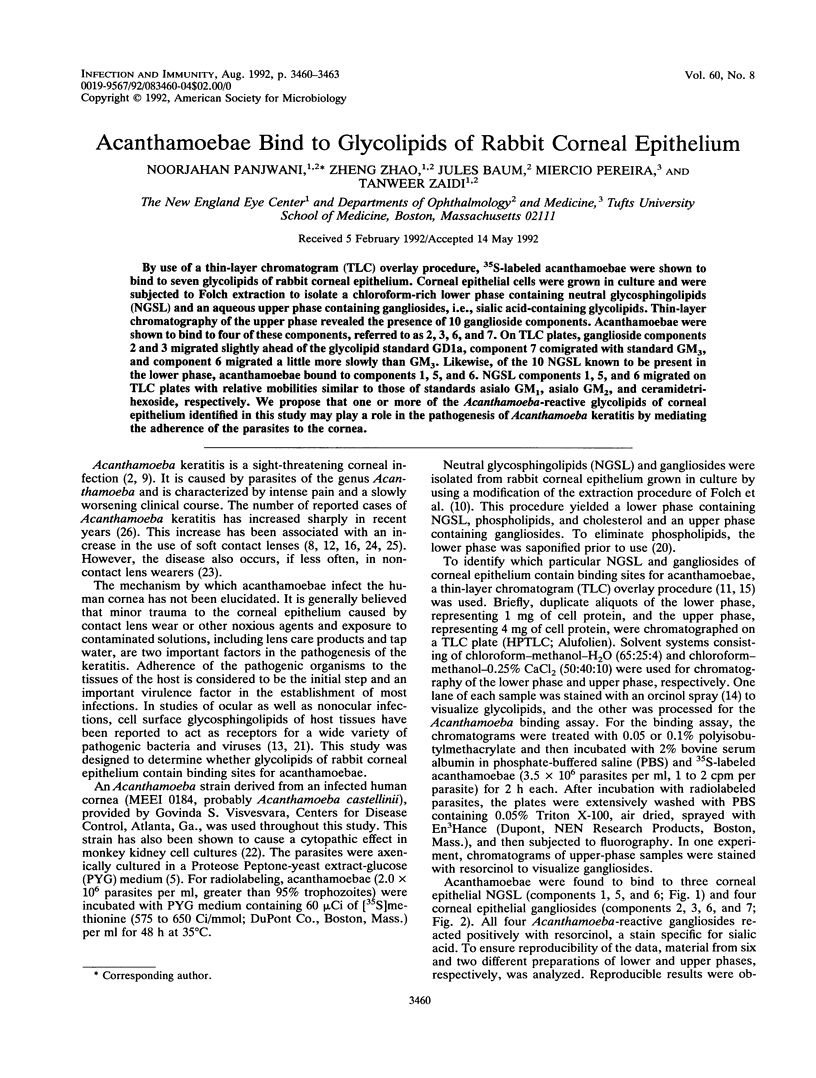
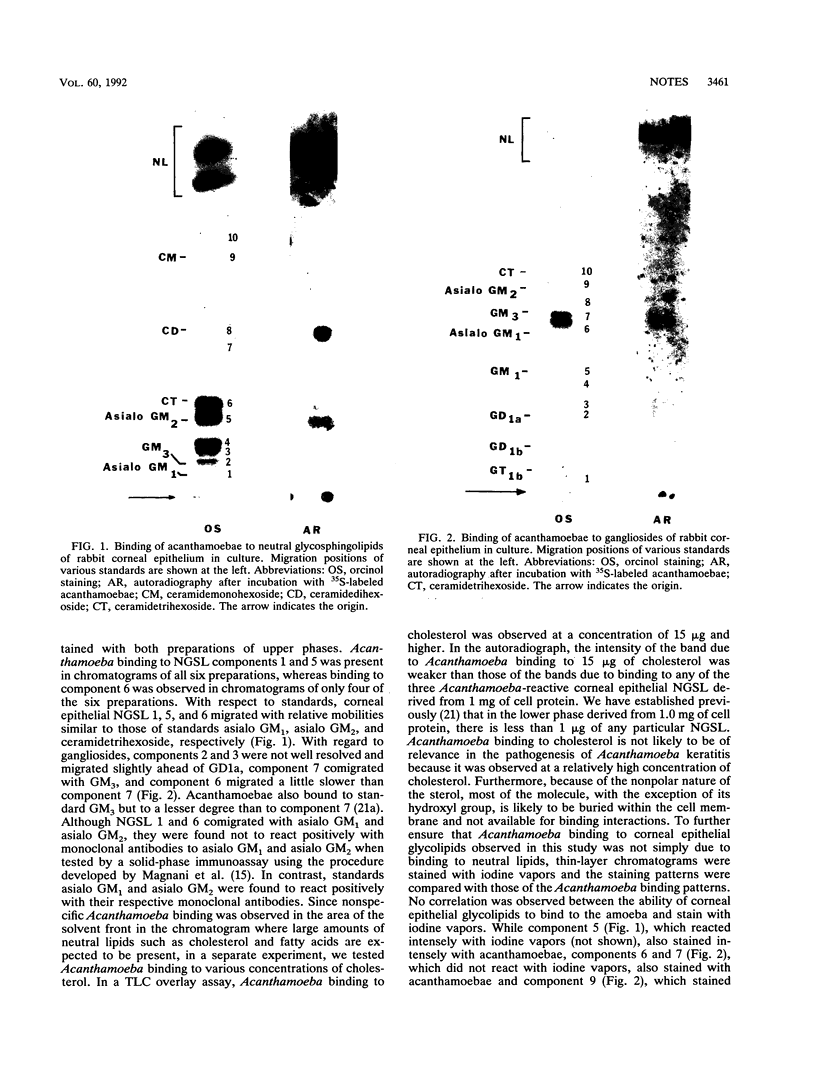
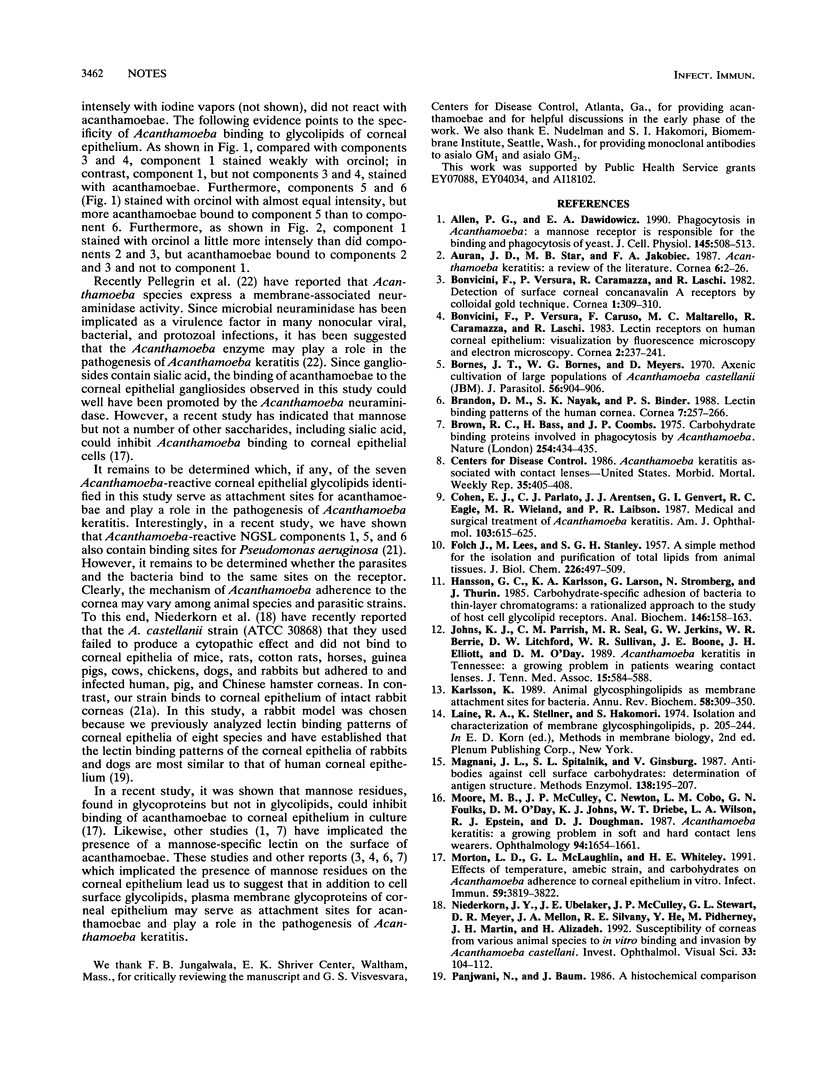
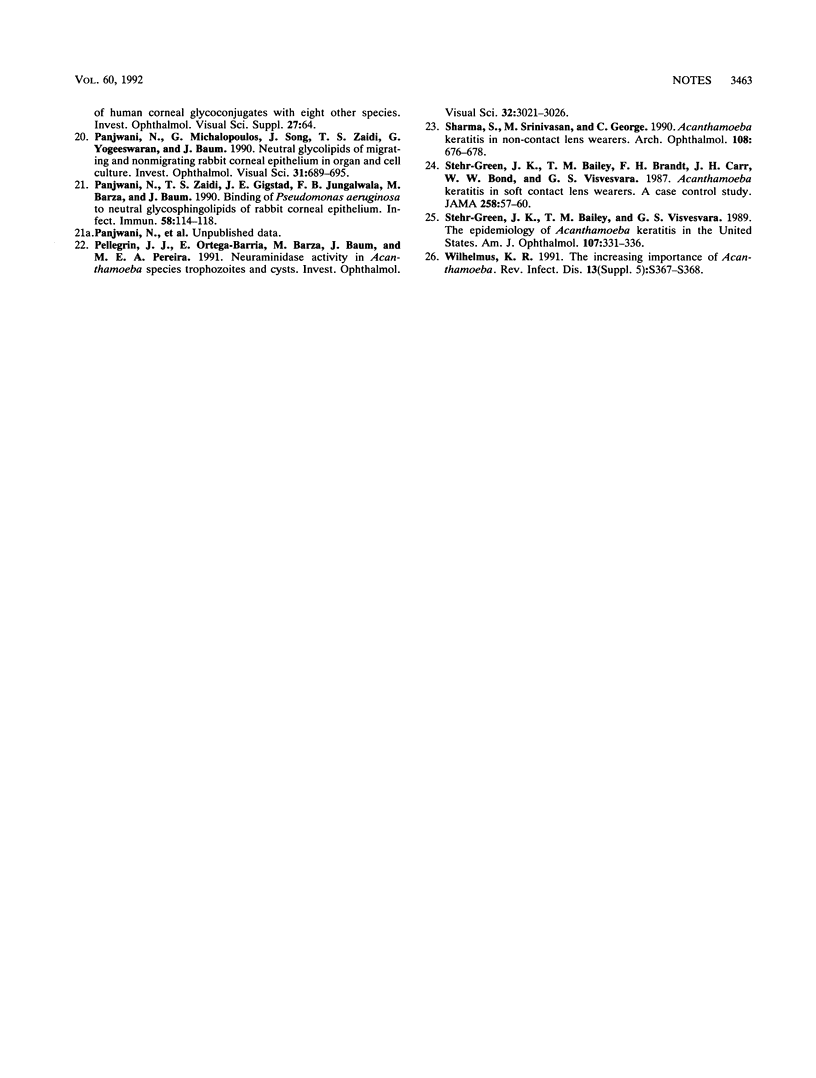
Images in this article
Selected References
These references are in PubMed. This may not be the complete list of references from this article.
- Allen P. G., Dawidowicz E. A. Phagocytosis in Acanthamoeba: I. A mannose receptor is responsible for the binding and phagocytosis of yeast. J Cell Physiol. 1990 Dec;145(3):508–513. doi: 10.1002/jcp.1041450317. [DOI] [PubMed] [Google Scholar]
- Auran J. D., Starr M. B., Jakobiec F. A. Acanthamoeba keratitis. A review of the literature. Cornea. 1987;6(1):2–26. [PubMed] [Google Scholar]
- Brandon D. M., Nayak S. K., Binder P. S. Lectin binding patterns of the human cornea. Comparison of frozen and paraffin sections. Cornea. 1988;7(4):257–266. [PubMed] [Google Scholar]
- Brown R. C., Bass H., Coombs J. P. Carbohydrate binding proteins involved in phagocytosis by Acanthamoeba. Nature. 1975 Apr 3;254(5499):434–435. doi: 10.1038/254434a0. [DOI] [PubMed] [Google Scholar]
- Cohen E. J., Parlato C. J., Arentsen J. J., Genvert G. I., Eagle R. C., Jr, Wieland M. R., Laibson P. R. Medical and surgical treatment of Acanthamoeba keratitis. Am J Ophthalmol. 1987 May 15;103(5):615–625. doi: 10.1016/s0002-9394(14)74320-x. [DOI] [PubMed] [Google Scholar]
- FOLCH J., LEES M., SLOANE STANLEY G. H. A simple method for the isolation and purification of total lipides from animal tissues. J Biol Chem. 1957 May;226(1):497–509. [PubMed] [Google Scholar]
- Hansson G. C., Karlsson K. A., Larson G., Strömberg N., Thurin J. Carbohydrate-specific adhesion of bacteria to thin-layer chromatograms: a rationalized approach to the study of host cell glycolipid receptors. Anal Biochem. 1985 Apr;146(1):158–163. doi: 10.1016/0003-2697(85)90410-5. [DOI] [PubMed] [Google Scholar]
- Jensen T., Barnes W. G., Meyers D. Axenic cultivation of large populations of Acanthamoeba castellanii (JBM). J Parasitol. 1970 Oct;56(5):904–906. [PubMed] [Google Scholar]
- Johns K. J., Parrish C. M., Seal M. R., Jerkins G. W., Berrie W. R., Litchford D. W., Sullivan W. R., Boone J. E., Elliott J. H., O'Day D. M. Acanthamoeba keratitis in Tennessee: a growing problem in patients wearing contact lenses. J Tenn Med Assoc. 1989 Nov;82(11):584–588. [PubMed] [Google Scholar]
- Karlsson K. A. Animal glycosphingolipids as membrane attachment sites for bacteria. Annu Rev Biochem. 1989;58:309–350. doi: 10.1146/annurev.bi.58.070189.001521. [DOI] [PubMed] [Google Scholar]
- Magnani J. L., Spitalnik S. L., Ginsburg V. Antibodies against cell surface carbohydrates: determination of antigen structure. Methods Enzymol. 1987;138:195–207. doi: 10.1016/0076-6879(87)38016-4. [DOI] [PubMed] [Google Scholar]
- Moore M. B., McCulley J. P., Newton C., Cobo L. M., Foulks G. N., O'Day D. M., Johns K. J., Driebe W. T., Wilson L. A., Epstein R. J. Acanthamoeba keratitis. A growing problem in soft and hard contact lens wearers. Ophthalmology. 1987 Dec;94(12):1654–1661. [PubMed] [Google Scholar]
- Morton L. D., McLaughlin G. L., Whiteley H. E. Effects of temperature, amebic strain, and carbohydrates on Acanthamoeba adherence to corneal epithelium in vitro. Infect Immun. 1991 Oct;59(10):3819–3822. doi: 10.1128/iai.59.10.3819-3822.1991. [DOI] [PMC free article] [PubMed] [Google Scholar]
- Niederkorn J. Y., Ubelaker J. E., McCulley J. P., Stewart G. L., Meyer D. R., Mellon J. A., Silvany R. E., He Y. G., Pidherney M., Martin J. H. Susceptibility of corneas from various animal species to in vitro binding and invasion by Acanthamoeba castellanii [corrected]. Invest Ophthalmol Vis Sci. 1992 Jan;33(1):104–112. [PubMed] [Google Scholar]
- Panjwani N., Michalopoulos G., Song J., Zaidi T. S., Yogeeswaran G., Baum J. Neutral glycolipids of migrating and nonmigrating rabbit corneal epithelium in organ and cell culture. Invest Ophthalmol Vis Sci. 1990 Apr;31(4):689–695. [PubMed] [Google Scholar]
- Panjwani N., Zaidi T. S., Gigstad J. E., Jungalwala F. B., Barza M., Baum J. Binding of Pseudomonas aeruginosa to neutral glycosphingolipids of rabbit corneal epithelium. Infect Immun. 1990 Jan;58(1):114–118. doi: 10.1128/iai.58.1.114-118.1990. [DOI] [PMC free article] [PubMed] [Google Scholar]
- Pillion D. J., Bartlett J. D., Meezan E., Yang M., Crain R. J., Grizzle W. E. Systemic absorption of insulin delivered topically to the rat eye. Invest Ophthalmol Vis Sci. 1991 Nov;32(12):3021–3027. [PubMed] [Google Scholar]
- Sharma S., Srinivasan M., George C. Acanthamoeba keratitis in non-contact lens wearers. Arch Ophthalmol. 1990 May;108(5):676–678. doi: 10.1001/archopht.1990.01070070062035. [DOI] [PubMed] [Google Scholar]
- Stehr-Green J. K., Bailey T. M., Brandt F. H., Carr J. H., Bond W. W., Visvesvara G. S. Acanthamoeba keratitis in soft contact lens wearers. A case-control study. JAMA. 1987 Jul 3;258(1):57–60. [PubMed] [Google Scholar]
- Stehr-Green J. K., Bailey T. M., Visvesvara G. S. The epidemiology of Acanthamoeba keratitis in the United States. Am J Ophthalmol. 1989 Apr 15;107(4):331–336. doi: 10.1016/0002-9394(89)90654-5. [DOI] [PubMed] [Google Scholar]
- Wilhelmus K. R. Introduction: the increasing importance of Acanthamoeba. Rev Infect Dis. 1991 Mar-Apr;13 (Suppl 5):S367–S368. doi: 10.1093/clind/13.supplement_5.s367. [DOI] [PubMed] [Google Scholar]



